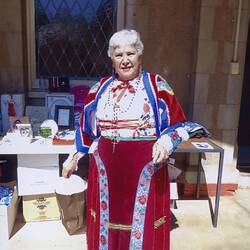Summary
Digital black and white photograph of Iole Crovetti and Vincenzo Marino, newly married, seated posing in the countryside outside Genoa, Italy, 1960 not long before they migrate to Australia.
This image forms part of a collection of images and regional textile ensembles brought to Australia by Iole Crovetti Marino. Iole arrived in Melbourne with her husband, Vincenzo on 26 December 1960 on the ship 'Sydney'.
The images document Iole's life in Australia, including being an accomplished cook working in different Melbourne establishments, and her participation and contribution to the Sardinian Cultural Association. She was a committee member for many years, prepared cultural foods and danced in folkloric costume as a means of preserving her heritage in Australia. Images also document Iole's life in Sardinia before migrating to Melbourne.
The costumes were made by Iole's mother, Anna Cabras, in Belvi in the 1950s, and represent traditional clothing worn when she was a teenager. They demonstrate variations in colour and design for everyday, special occasion and festival wear (Sardinian towns all had their own versions of the clothing). These costume traditions date back hundreds of years in Sardinia and many other regions of Italy.
Physical Description
Digital photograph provided in digital format
Significance
This collection provides a significant representation of traditional Sardinian life and cultural practices subsequently transported to Australia through migration, and retained as part of the preservation and maintenance of cultural life. It demonstrates the diversity of dress customs between towns and regions within one country, as well as diversity across cultures within the context of the museum's regional clothing collection.
This collection of traditional Sardinian clothing and related photographs were donated to the Museum by Iole Crovetti Marino in collaboration with the Sardinian Cultural Association (Victoria) Inc.
These are precious migration objects which were of importance in the expression of identity and place in the country of origin and have played a role in the activities of community organisations, in this case the Sardinian Cultual Association. Like similar associations, maintaining cultural practices and customs is increasingly challenging as subsequent generations become further distanced from the original migrant generation and through the natural process of community settlement, integration and assimilation within the context of a multiculturally diverse society.
The Museum holds a significant collection relating to Italian migration, settlement and cultural life in Victoria, including that developed in collaboration with the Italian Historical Society CO.AS.IT. However, aside from a traditional Carabinieri uniform from the late 1800s and a hat and belt from the south Tyrolean region, there are no regional ensembles from Italy represented in the collection.
The Museum does hold a range of regional ensembles, or components, from Latvia, Estonia, Poland, South Africa, Albania, Scotland, Greece, Hungary, Ukraine, Slovenia and Argentina - so this collection of complete regional ensembles which cross gender and age, with accompanying photographs, are of enormous cultural significance.
More Information
-
Collecting Areas
Migration & Cultural Diversity, Home & Community, Images & Image Making, Leisure
-
Person Depicted
-
Person Depicted
-
Format
Digital file, Black & White
-
Classification
-
Category
-
Discipline
-
Type of item
-
Keywords
Villages, Leisure, Memorabilia, Italian Immigration, Families, Italian Communities

